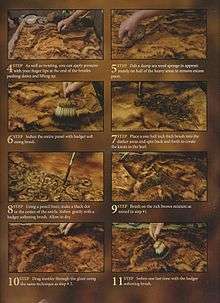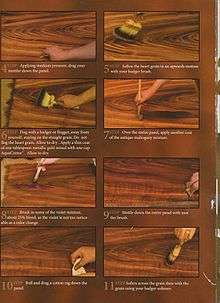Graining


Graining is the practice of imitating wood grain on a non-wood surface in order to increase that surface's aesthetic appeal. Graining was common in the 19th century, as people were keen on imitating hard, expensive woods by applying a superficial layer of paint onto soft, inexpensive woods. Graining can be accomplished using either rudimentary tools or highly specialized graining tools. A specialized thick brush used for graining is often called a mottler. It is carried out in layers, with the first layer being a base, and then a second layer applied later, today usually by means of a sponge. During the 19th century, however, brushes were more commonly used. Graining can also be applied on bricks and brass, as is more common today.
Graining can also mean the production of any artificial texture on any surface. For example, in printing, by making the smooth metal sheets used in modern printing processes coarse. A stone working equivalent of graining is marbling.
History
A book entitled The Museum of Antiquity, in which a description is given of the Egyptian trades three thousand years ago, the following: Boxes, chairs, tables, etc., were often made of ebony inlaid with ivory, sycamore, and acacia veneering with thin layers and carved devices of rare woods added as ornament on inferior surfaces; and a fondness for display induced the Egyptians to paint common boards to imitate foreign varieties so generally practiced at the present day. The colors were usually applied on a thin coating of stucco or a ground smoothly laid on prepared wood and the various knots and grains made to resemble the wood they were intended to counterfeit. This account would appear to indicate that grainers were a professional class of artisans over three thousand years ago. Perhaps the principal reason why a decorator should be conversant with the production of graining is that sooner or later in his career he will may be called upon to execute it. This being so, he should be in a position to supply the demand.
Graining is the art of imitating the different types of natural wood grain It ranges from simple Clair Bois to intricate English Walnut. There are basically two types of wood graining: Coarse(rustic) and Fine(polite). In fine graining, layers are built up using water colors and finished with an oil glaze. For the water colors use a beer solution tinted with a pigment, Indian inks, or Vandyke crystals dissolved in water. Vandyke crystals are very dark, almost a match for burnt umber but by varying the amount of water you can get a color range from pale brown to nearly black.
Tools for graining
A few special tools, in addition to those employed in ordinary house painting, are necessary for graining, although it may be observed that some of the best examples of graining have been carried out with only a minimum of tools. However, while the experienced craftsman can often obtain just the effects required by the deft manipulation of an old rag or a wornout brush, it is an advantage for the beginner to have the proper implements.
References
- Oestreicher, Lisa, 'Imitation Timber Graining in the 18th and 19th Centuries', The Building Conservation Directory 2014
| Look up graining in Wiktionary, the free dictionary. |